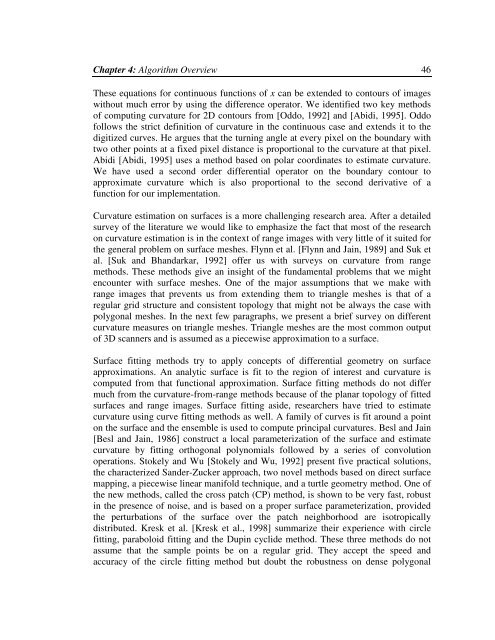To the Graduate Council: I am submitting herewith a thesis written by ...
To the Graduate Council: I am submitting herewith a thesis written by ...
To the Graduate Council: I am submitting herewith a thesis written by ...
You also want an ePaper? Increase the reach of your titles
YUMPU automatically turns print PDFs into web optimized ePapers that Google loves.
Chapter 4: Algorithm Overview 46These equations for continuous functions of x can be extended to contours of imageswithout much error <strong>by</strong> using <strong>the</strong> difference operator. We identified two key methodsof computing curvature for 2D contours from [Oddo, 1992] and [Abidi, 1995]. Oddofollows <strong>the</strong> strict definition of curvature in <strong>the</strong> continuous case and extends it to <strong>the</strong>digitized curves. He argues that <strong>the</strong> turning angle at every pixel on <strong>the</strong> boundary withtwo o<strong>the</strong>r points at a fixed pixel distance is proportional to <strong>the</strong> curvature at that pixel.Abidi [Abidi, 1995] uses a method based on polar coordinates to estimate curvature.We have used a second order differential operator on <strong>the</strong> boundary contour toapproximate curvature which is also proportional to <strong>the</strong> second derivative of afunction for our implementation.Curvature estimation on surfaces is a more challenging research area. After a detailedsurvey of <strong>the</strong> literature we would like to emphasize <strong>the</strong> fact that most of <strong>the</strong> researchon curvature estimation is in <strong>the</strong> context of range images with very little of it suited for<strong>the</strong> general problem on surface meshes. Flynn et al. [Flynn and Jain, 1989] and Suk etal. [Suk and Bhandarkar, 1992] offer us with surveys on curvature from rangemethods. These methods give an insight of <strong>the</strong> fund<strong>am</strong>ental problems that we mightencounter with surface meshes. One of <strong>the</strong> major assumptions that we make withrange images that prevents us from extending <strong>the</strong>m to triangle meshes is that of aregular grid structure and consistent topology that might not be always <strong>the</strong> case withpolygonal meshes. In <strong>the</strong> next few paragraphs, we present a brief survey on differentcurvature measures on triangle meshes. Triangle meshes are <strong>the</strong> most common outputof 3D scanners and is assumed as a piecewise approximation to a surface.Surface fitting methods try to apply concepts of differential geometry on surfaceapproximations. An analytic surface is fit to <strong>the</strong> region of interest and curvature iscomputed from that functional approximation. Surface fitting methods do not differmuch from <strong>the</strong> curvature-from-range methods because of <strong>the</strong> planar topology of fittedsurfaces and range images. Surface fitting aside, researchers have tried to estimatecurvature using curve fitting methods as well. A f<strong>am</strong>ily of curves is fit around a pointon <strong>the</strong> surface and <strong>the</strong> ensemble is used to compute principal curvatures. Besl and Jain[Besl and Jain, 1986] construct a local par<strong>am</strong>eterization of <strong>the</strong> surface and estimatecurvature <strong>by</strong> fitting orthogonal polynomials followed <strong>by</strong> a series of convolutionoperations. Stokely and Wu [Stokely and Wu, 1992] present five practical solutions,<strong>the</strong> characterized Sander-Zucker approach, two novel methods based on direct surfacemapping, a piecewise linear manifold technique, and a turtle geometry method. One of<strong>the</strong> new methods, called <strong>the</strong> cross patch (CP) method, is shown to be very fast, robustin <strong>the</strong> presence of noise, and is based on a proper surface par<strong>am</strong>eterization, provided<strong>the</strong> perturbations of <strong>the</strong> surface over <strong>the</strong> patch neighborhood are isotropicallydistributed. Kresk et al. [Kresk et al., 1998] summarize <strong>the</strong>ir experience with circlefitting, paraboloid fitting and <strong>the</strong> Dupin cyclide method. These three methods do notassume that <strong>the</strong> s<strong>am</strong>ple points be on a regular grid. They accept <strong>the</strong> speed andaccuracy of <strong>the</strong> circle fitting method but doubt <strong>the</strong> robustness on dense polygonal
















